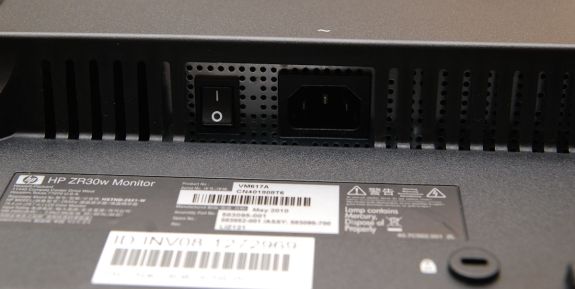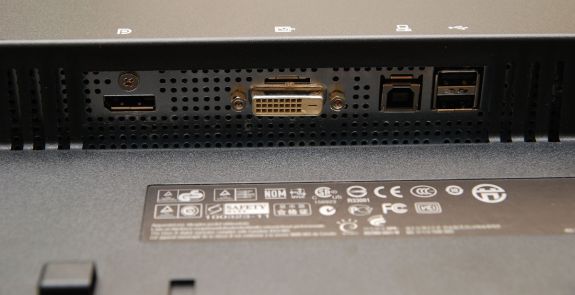A New 30" Contender: HP ZR30w Review
by Brian Klug on June 1, 2010 6:30 PM ESTThe LCD market continues to be one of the frequently updated segments in the consumer electronics segment, as OEMs and vendors alike are eager to bundle their high-end, high performance displays with professional workstations. The ZR30w belongs to that same pro market, offering a 10-bit panel with 1.07 billion colors - for an advertised 99 percent coverage of the AdobeRGB 1998 gamut and 30-bit per pixel color. HP claims that the ZR30w is the first 30" display to break 1 billion colors. When you’re selling a 30” LCD to enthusiasts, every bit of performance matters, and as we’ll show in a bit, the ZR30w doesn’t fail to impress.
As already noted, the ZR30w is targeted primarily at enthusiasts and professionals who demand accurate color tracking and equally large gamut. As with all 30” displays, every detail counts, as this segment represents generally the best of the best for manufacturers. It makes sense, too, since enthusiasts and professionals alike who are serious about getting the absolute largest in display real-estate also care about color tracking and gamut. They expect top performance, and are willing to pay for it. Though similar real-estate can almost be captured with arrays of smaller panels, for most, the 30” segment remains the most lust-worthy among displays thanks to the truly uninterrupted space.
The last 30” HP LCD we touched was the venerable HP LP3065 back in 2007. The LP3065 is still available today as well at $1,349 on HP’s website. The ZR30w is being introduced at a price point of $1,299 - some $300 below Dell’s UltraSharp 3008WFP display. Interestingly enough, the ZR30w does away with the plethora of DVI-D ports we praised the LP3065 for having (almost doubling as a KVM switch). It trims down the 3 DVI-D ports in the LP3065 to 1 DVI-D port and a DisplayPort for the ZR30w. That’s not a deal breaker, but you’re still one input shorter a generation later, which is a bit puzzling. Considering other 30” displays include a plethora of input options, we find the ZR30’s a bit spartan - an HDMI port or component would be welcome additions.
Before we go any further though, let’s dive into the specifications:
| HP ZR30w - Specifications | |||
| Property | Quoted Specification | ||
| Video Inputs | DVI-D, DisplayPort (both with HDCP) | ||
| Panel Type | S-IPS/H2-IPS (CN401808T6 unknown manufacturer) | ||
| Pixel Pitch | 0.250 mm | ||
| Colors | 1.07 billion colors (30 bits) | ||
| Brightness | 370 nits typical | ||
| Contrast Ratio | 1000:1 normal, 3000:1 (dynamic) | ||
| Response Time | 7ms (g2g), 12ms (on to off) | ||
| Viewable Size | 29.7" Diagonal | ||
| Resolution | 2560x1600 (WQXGA) | ||
| Viewing Angle | 178 degrees horizontal and vertical | ||
| Power Consumption (operation) | <130 watts typical, <185 watts maximum | ||
| Power Consumption (standby) | <2 watts sleep | ||
| Screen Treatment | Matte (anti-glare) | ||
| Height-Adjustable | Yes: 4" of travel | ||
| Tilt | Yes: -5 degrees to 35 degrees | ||
| Pivot | No | ||
| Swivel | Yes: -45 degrees to 45 degrees | ||
| VESA Wall Mounting | Yes - 100x100mm | ||
| Dimensions w/ Base (WxHxD) | 27.3" x 19.3" - 23.3" x 10.8" | ||
| Weight w/o Stand | 28.6 lbs | ||
| Additional Features | Integrated 4-port USB hub, HP Quick Release, optional speaker bar | ||
| Limited Warranty | 3 years parts, labor, and onsite service | ||
| Accessories | DVI-D, DisplayPort, USB, and Power Cables | ||
| Price | $1,299.00 | ||
We’ve already talked about the ports, but in case you haven’t used a 30” or equally high resolution panel before, note that dual link DVI is an absolute must. Luckily, HP ships a dual link DVI cable (I’ve seen a few monitors that require dual link DVI actually ship without dual link cables, which always results in a few nightmares) and makes note of it in the instruction manual.
Just don’t expect passive DisplayPort to DVI adapters or other single link DVI interfaces to drive the ZR30w; it won’t work. I experimented with a single link connection just for fun, and the ZR30w refused to show an image. There’s nothing wrong with that, it’s entirely expected. Just be sure you check your cables if things aren’t making sense.

There’s also an internal 4-port USB 2.0 hub. Two ports on the left side of the monitor, two on the bottom near the display inputs. Alongside the standard power connector is a power switch - been a long time since I’ve seen one of those on a monitor.












95 Comments
View All Comments
mcklevin - Monday, June 28, 2010 - link
I now have had this monitor for a week, and it has performed quite well, it is a very solid professional looking build. The anti-glare screen does not sparkle like the LG screen, and the black levels are better as well. Text looks much better than the LG too.Right now I do not have a calibrator. The color accuracy is pretty good, It does get hot it the high end like many of the wide gamut monitors. Dropping the digital vibrancy to 44 in the nvidia control panel has helped a lot with the saturation. The viewing angles are nice, horizontal I would give an 9, vertical 7. I didn't notice input lag in Mass Effect 2. I use this monitor for Cinema 4D and Aftereffects.
AlphaJarmel - Wednesday, June 23, 2010 - link
So this monitor is pretty much useless for gaming as Windows will ignore the calibration.SoCalRich - Thursday, July 1, 2010 - link
Brian,Thanks for your review!!!
I have a new 17" MacBook Pro i7. I was curios if you were able to hook up your MBP to this monitor using the displayport cable?
I think this would be a great monitor for my Photoshop & Lightroom editing. I've been looking at the 30" ACD. This looks like a better monitor.
I'm still a little confused about how you make any adjustments w/o OSD????
SoCalRich - Thursday, July 1, 2010 - link
My new 17" MacBook Pro i7 uses the Intel HD Graphics for regular web surfing etc. It then switches to the NVIDIA GeForce GT 330M when I open Photoshop and Lightroom.I'm hoping these cards will support this monitor using the displayport cable.
tsittard - Saturday, July 3, 2010 - link
I picked this monitor up for a 3rd editing monitor to be used with Final Cut Pro, AJA Kona 3 card, and a blackmagic conversion box that goes from HD-SDI to dual link dvi-d.Here's the link:
http://www.blackmagic-design.com/products/hdlink/t...
I'm not getting any picture....
I'm currently using the zr30w as a second computer monitor, which is working fine at 2500x1600 coming off my Mac Pro, but this is not what I intended...
Is it not possible to send this monitor a 1920x1080 signal via dvi-d and have it upscale to fill it?
I'm also using 2 hp zr24w's for my computer monitors, and I've hooked up the blackmagic box to one of those and everything works great...
My settings inside of FCP are for a 1080 23.98psf 10bit signal, again it seems to work fine going into the ZR24w
I sense that there should be a simple answer here but I'm not finding it....
the blackmagic converter box also comes in a display port version, will that allow me to send the HD resolution to the zr30w?
Mr. Klug, any suggestions?
B3an - Tuesday, August 10, 2010 - link
Brian - you mentioned you used to i1 Display 2 to calibrate this monitor, i have both this monitor and the i1D2, can you tell me what settings you used?I find if a default white point is not selected then the colours and especially greys have a red tint to 'em. Did you try it with the Eye-One Match 3 software that comes with the i1D2? Thanks.
humba - Sunday, August 15, 2010 - link
Has anyone who actually got the monitor noticed a buzzing/humming noise coming from the screen as soon as there's a video input signal?The noise is similar to the feedback noise you get on an audio system if there's an issue with the grounding, and it only goes away if the brightness is increased to 80% or higher.
I've already RMA'ed my device once (they sent out a replacement only hours after receiving the case which makes me thing it's a known defect), but the replacement exhibits the exact same behavior. I've gone through a bunch of different DP cables, tried with various DVI cables, too, on 4 different computers (HP EliteBook 8540p, Acer Timelize 3810TZ, Mac Mini 2009 and a self-assembled box) and went around the house trying different electrical phases but to no avail.
And I seem not to be the only one since I found this test that mentions the same issue: http://www.productwiki.com/hp-zr30w/. And, strangely enough, the support documents at HP's site also has a support document (albeit a very old one ): http://h20000.www2.hp.com/bizsupport/TechSupport/D... which doesn't really have any relation to the display in question other than the 80% brightness mentioned which seems to be the fix from 2003 on.
martinz - Tuesday, November 1, 2011 - link
Yes. Mine did it, got it replaced, same issue.HP in the US confirmed they all do it below 80% brightness, but tried to claim all/most large panels do it.
I think it is completely unacceptable for a monitor at this price - and I am shocked that HP don't agree. Otherwise, I like it a lot: great picture and build quality.
In a busy office it would not be noticeable, and if you can live with the (for me) eyeball melting full brightness, or are not sensitive to ambient noise, it's not an issue either.
For me it's a show stopper. Mine is going back, but not sure what to replace it with.
BikeDude - Friday, August 27, 2010 - link
Do all displays support HDCP these days, or will I still need AnyDVDHD in the future if I have to replace my current 30" Apple Cinema display?fontajos - Monday, September 13, 2010 - link
Hi Brian,thanks for your extensive test on the HP Z30w. I just bought the z30w and was very disappointed by the strong blue at 9000 Kelvin. I installed the hp ICM profile but nothing changed. I want to have a 6500K screen (like all other monitors here). Is it possible to send me your ICM file or can you suggest me a way to get my white to real-white and not blueish-white? If the only solution is to use a hardware calibration, can you suggest me a product?